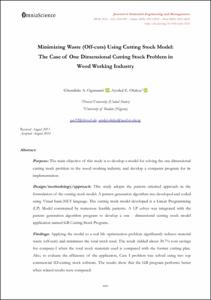Mostra el registre d'ítem simple
Minimizing waste (off-cuts) using cutting stock model: the case of one dimensional cutting stock problem in wood working industry
| dc.contributor.author | Ogunranti, Gbemileke A. |
| dc.contributor.author | Oluleye, Ayodeji E. |
| dc.date.accessioned | 2016-11-02T18:47:13Z |
| dc.date.available | 2016-11-02T18:47:13Z |
| dc.date.issued | 2016-10 |
| dc.identifier.citation | Ogunranti, Gbemileke A.; Oluleye, Ayodeji E. Minimizing waste (off-cuts) using cutting stock model: the case of one dimensional cutting stock problem in wood working industry. "Journal of Industrial Engineering and Management", Octubre 2016, vol. 9, núm. 3, p. 834-859. |
| dc.identifier.issn | 2013-0953 |
| dc.identifier.uri | http://hdl.handle.net/2117/91389 |
| dc.description.abstract | Purpose: The main objective of this study is to develop a model for solving the one dimensional cutting stock problem in the wood working industry, and develop a computer program for its implementation. Design/methodology/approach: This study adopts the pattern oriented approach in the formulation of the cutting stock model. A pattern generation algorithm was developed and coded using Visual basic.NET language. The cutting stock model developed is a Linear Programming (LP) Model constrained by numerous feasible patterns. A LP solver was integrated with the pattern generation algorithm program to develop a one - dimensional cutting stock model application named GB Cutting Stock Program. Findings: Applying the model to a real life optimization problem significantly reduces material waste (off-cuts) and minimizes the total stock used. The result yielded about 30.7% cost savings for company-I when the total stock materials used is compared with the former cutting plan. Also, to evaluate the efficiency of the application, Case I problem was solved using two top commercial 1D-cutting stock software. The results show that the GB program performs better when related results were compared. Research limitations/implications: This study round up the linear programming solution for the number of pattern to cut. Practical implications: From Managerial perspective, implementing optimized cutting plans increases productivity by eliminating calculating errors and drastically reducing operator mistakes. Also, financial benefits that can annually amount to millions in cost savings can be achieved through significant material waste reduction. Originality/value: This paper developed a linear programming one dimensional cutting stock model based on a pattern generation algorithm to minimize waste in the wood working industry. To implement the model, the algorithm was coded using VisualBasic.net and linear programming solver called lpsolvedll (dynamic link library) was integrated to develop a one dimensional cutting stock Program. |
| dc.format.extent | 26 p. |
| dc.language.iso | eng |
| dc.publisher | OmniaScience |
| dc.rights | Attribution-NonCommercial 3.0 Spain |
| dc.rights.uri | http://creativecommons.org/licenses/by-nc/3.0/es/ |
| dc.subject | Àrees temàtiques de la UPC::Matemàtiques i estadística::Investigació operativa |
| dc.subject | Àrees temàtiques de la UPC::Economia i organització d'empreses::Direcció d'operacions |
| dc.subject.lcsh | Mathematical optimization |
| dc.subject.lcsh | Manufacturing processes |
| dc.subject.other | 1D-cutting stock problem |
| dc.subject.other | Cutting stock model |
| dc.subject.other | Pattern generation algorithm |
| dc.subject.other | Linear programming |
| dc.title | Minimizing waste (off-cuts) using cutting stock model: the case of one dimensional cutting stock problem in wood working industry |
| dc.type | Article |
| dc.subject.lemac | Optimització matemàtica |
| dc.subject.lemac | Optimització industrial |
| dc.subject.lemac | Fabricació -- Optimització |
| dc.identifier.doi | 10.3926/jiem.1653 |
| dc.identifier.dl | B-28744-2008 |
| dc.description.peerreviewed | Peer Reviewed |
| dc.rights.access | Open Access |
| local.citation.publicationName | Journal of Industrial Engineering and Management |
| local.citation.volume | 9 |
| local.citation.number | 3 |
| local.citation.startingPage | 834 |
| local.citation.endingPage | 859 |
Fitxers d'aquest items
Aquest ítem apareix a les col·leccions següents
-
2016, vol. 9, núm. 3 [12]


